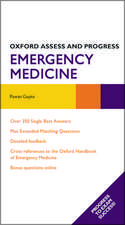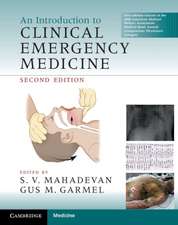Practical Assessment and Treatment of the Patient with Headaches in the Emergency Department and Urgent Care Clinic
Autor Dawn A. Marcus, Philip A. Bainen Limba Engleză Paperback – 29 iul 2011
There currently are no widely used guidelines for the treatment of patients with headache in the ER or UCC, and reducing the number of CT scans remains a key goal for administrators in many ER or urgent care settings. In one study, 35 drugs, alone or in combination, were used to treat migraine. The most common medication class used was narcotics, which were used in 25% of the visits. The next two most commonly used classes were antiemetics and NSAIDs. Only 5% of patients seen for headache received headache-specific medications during their visit.
ER and Urgent Care physicians generally have little or no formal training in treating these patients. Consequently, they often feel less comfortable ruling out secondary causes of headaches and using appropriate headache treatment medications and procedures. Since many patients have received narcotics in previous visits, providers may view them as drug seekers. Patients seen in ERs and UCCs for acute treatment of their headaches often report high levels of dissatisfaction. They often end up in the ER or UCC because they don’t have a formal treatment strategy for their severe headaches.
Health plans and insurance agencies are often frustrated by the high cost of fragmented care for patients with headaches. Because of the environment that most ER and UCC providers operate in, many unnecessary scans and tests are done because of uncertainty of the diagnosis and unfamiliarity of the patient. Primary care physicians are also frustrated by patients with headaches presenting to them after being seen in the ERor UCC, wanting a refill of their narcotics that they were given. Many patients don’t follow up with their PCPs and simply keep returning to the ER/UCC for their treatment.
In short, all involved in the care for patients with headache are frustrated by the current system. The care for these patients is clearly not optimal. It doesn’t have to be that way. There are a wide variety of effective treatment options available, but are underutilized in the acute setting. With these treatment options, patients no longer have to be treated only with parenteral narcotics, only to perpetuate the cycle of suboptimal care described above.
This concise handbook covers all aspects of acute headache care, including care of the child and adolescent with acute headaches, treatment of pregnant and breastfeeding women with acute headaches and appropriate evaluation of secondary headaches. In addition, two other novel chapters are included: one on caring for older patients with acute headaches as well as a chapter describing how to ensure a seamless transition of the patient back to a headache interested provider.
Representing an important milestone in the care of patients with headache, this is the first concise handbook available to exclusively address the issue of headache treatment in the acute care setting. Including protocols and strategies that can be used right away, Management of Headaches in Emergency Room and Urgent Care Settings: Diagnosis and Management provides information about lesser known, but effective strategies such as greater occipital nerve blocks that can be easily learned and incorporated in the acute care setting. It emphasizes the continuity of care that is so vital to keep headache patients from returning to the ER and UCC for acute treatment.
Preț: 364.74 lei
Preț vechi: 383.93 lei
-5% Nou
Puncte Express: 547
Preț estimativ în valută:
69.80€ • 75.79$ • 58.63£
69.80€ • 75.79$ • 58.63£
Carte tipărită la comandă
Livrare economică 22 aprilie-06 mai
Preluare comenzi: 021 569.72.76
Specificații
ISBN-13: 9781461400011
ISBN-10: 1461400015
Pagini: 224
Ilustrații: XII, 212 p. 57 illus., 52 illus. in color.
Dimensiuni: 155 x 235 x 18 mm
Greutate: 0.32 kg
Ediția:2011
Editura: Springer
Colecția Springer
Locul publicării:New York, NY, United States
ISBN-10: 1461400015
Pagini: 224
Ilustrații: XII, 212 p. 57 illus., 52 illus. in color.
Dimensiuni: 155 x 235 x 18 mm
Greutate: 0.32 kg
Ediția:2011
Editura: Springer
Colecția Springer
Locul publicării:New York, NY, United States
Public țintă
Professional/practitionerCuprins
Acknowledgements.- Preface.- Overview of headache in the emergency department.- Getting started.- Secondary headaches.- General treatment strategies.- Treating the child and adolescent with acute headache.- Treatment of pregnant and breastfeeding patients with acute headache in the ED.- Treatment of the older adult patient (>50 years old) with acute headache in the ED.- Managing risk in the ED.- After the ED: arranging post-ED follow-up care.
Textul de pe ultima copertă
Migraine is an extremely common condition affecting approximately 28 million Americans. Fully 1 in every 6 adult women suffers from this malady. Patients with migraine are frequently seen in the Emergency Room and Urgent Care Clinic for acute treatment of their headaches.
ER and Urgent Care physicians generally have little or no formal training in treating these patients. Consequently, they often feel less comfortable ruling out secondary causes of headaches and using appropriate headache treatment medications and procedures.
Practical Assessment and Treatment of the Patient with Headaches in the Emergency Department and Urgent Care Clinic covers all aspects of acute headache care, including care of the child and adolescent with acute headaches, treatment of pregnant and breastfeeding women with acute headaches and appropriate evaluation of secondary headaches.
Representing an important milestone in the care of patients with headache, this is the first resource available to exclusively address the issue of headache treatment in the acute care setting. Including protocols and strategies that can be used right away, Practical Assessment and Treatment of the Patient with Headaches in the Emergency Department and Urgent Care Clinic provides information about lesser known, but effective strategies such as greater occipital nerve blocks that can be easily learned and incorporated in the acute care setting. Emphasizing the continuity of care that is so vital to keep headache patients from returning to the ER and UCC for acute treatment, Practical Assessment and Treatment of the Patient with Headaches in the Emergency Department and Urgent Care Clinic is an invaluable addition to the literature.
ER and Urgent Care physicians generally have little or no formal training in treating these patients. Consequently, they often feel less comfortable ruling out secondary causes of headaches and using appropriate headache treatment medications and procedures.
Practical Assessment and Treatment of the Patient with Headaches in the Emergency Department and Urgent Care Clinic covers all aspects of acute headache care, including care of the child and adolescent with acute headaches, treatment of pregnant and breastfeeding women with acute headaches and appropriate evaluation of secondary headaches.
Representing an important milestone in the care of patients with headache, this is the first resource available to exclusively address the issue of headache treatment in the acute care setting. Including protocols and strategies that can be used right away, Practical Assessment and Treatment of the Patient with Headaches in the Emergency Department and Urgent Care Clinic provides information about lesser known, but effective strategies such as greater occipital nerve blocks that can be easily learned and incorporated in the acute care setting. Emphasizing the continuity of care that is so vital to keep headache patients from returning to the ER and UCC for acute treatment, Practical Assessment and Treatment of the Patient with Headaches in the Emergency Department and Urgent Care Clinic is an invaluable addition to the literature.
Caracteristici
First handbook available to exclusively address the issue of headache treatment in the acute care setting Practical, easy to use handbook that allows ER and UCC providers to treat patients with headache efficiently and effectively with protocols and strategies that can be used right away Of value to primary care providers in helping reduce the number of ER and UCC visits






